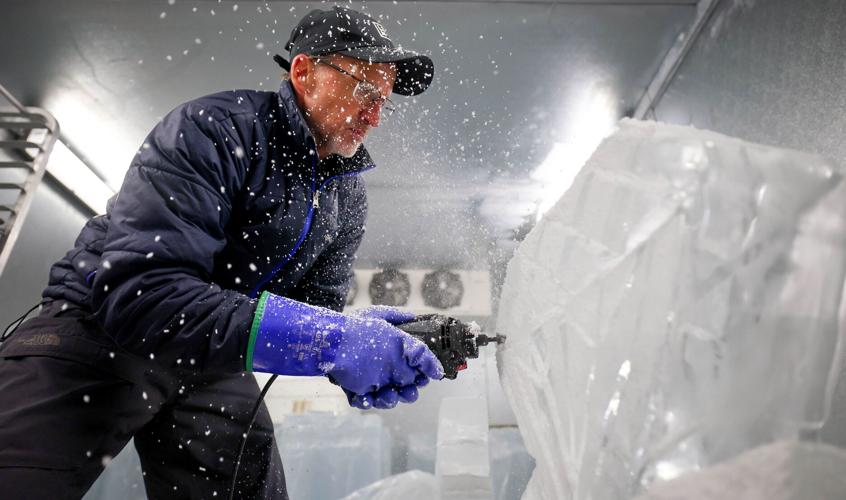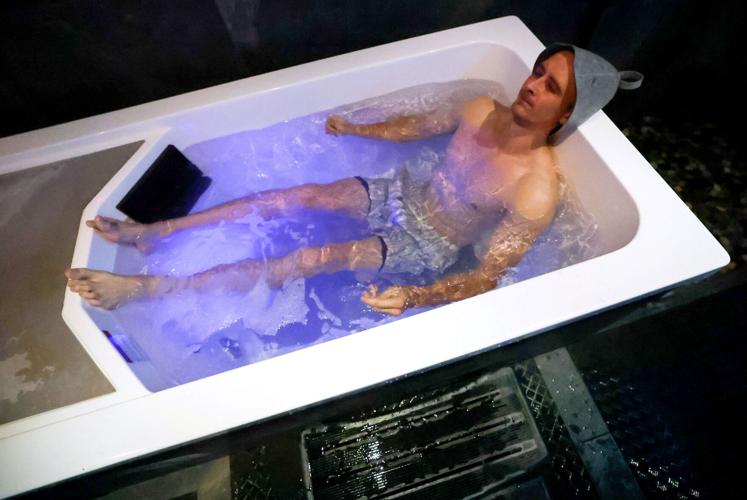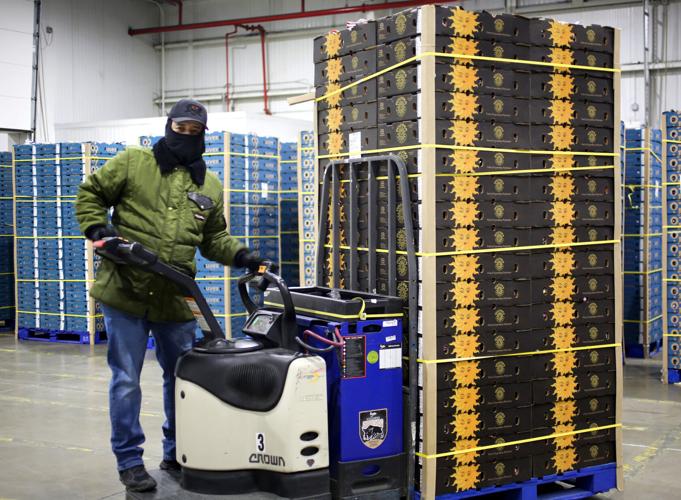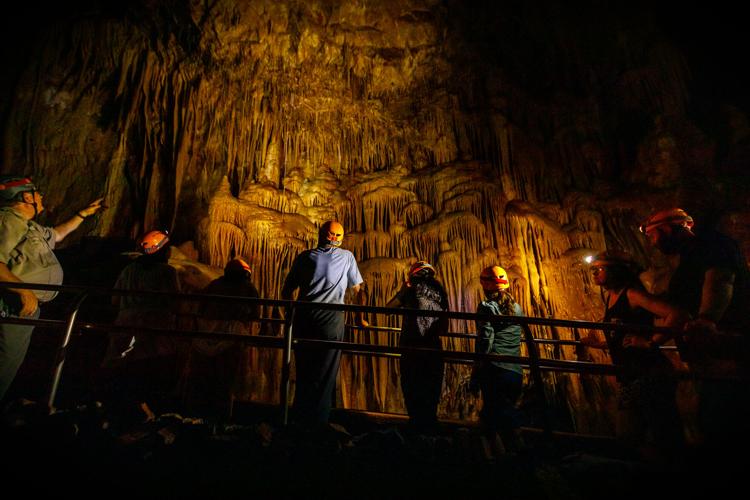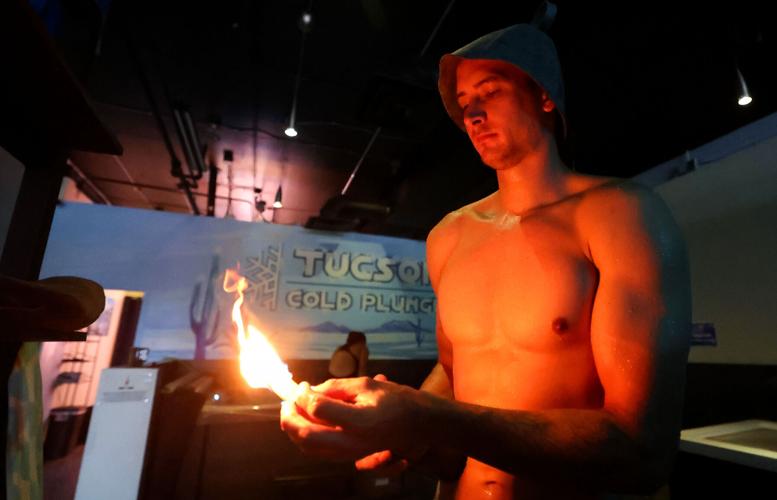For the longest time Matt Smith thought he was built for the manual labor of his job changing big-rig tires for stranded drivers along I-10 from Tucson to the New Mexico state line and the Mexican border and all points in between.
It wasnŌĆÖt a bad gig in the winter, but once the summer heat came on ...
ŌĆ£You gotta try to get out and work fast and get back into the truck,ŌĆØ Smith said of those days when he would do six, seven changes on an eight-hour shift, more if it was his after-hours on-call week. ŌĆ£It was brutal. There was no way around it.ŌĆØ
This summer, the hottest Smith gets is walking from his car into his brotherŌĆÖs 3-year-old contrast therapy business in midtown.
Instead of changing tires on broken-down backhoes and tractor-trailers with the sun beating down, heŌĆÖs helping people ŌĆ£cool down and feel betterŌĆØ as part of recovery and wellness.
People are also reading…

Matt Smith clenches his body while taking a plunge inside of Tucson Cold Plunge, 3017 E. Speedway, on a July day.
Talk about your ŌĆ£cool jobs.ŌĆØ
Smith has what we like to call a summer dream job, one that makes you forget that the temperature outside just topped the century mark and itŌĆÖs barely 11 a.m.
We found four ŌĆ£coolŌĆØ summer jobs that make you forget itŌĆÖs summer in the desert.
Taking an icy plunge
In the middle of the Ohio winter, when Matt and Luke Smith were little kids, theyŌĆÖd jump in their uncleŌĆÖs hot tub. With the steam still rising off their wet bodies, theyŌĆÖd jump out and run around in the snow.
ŌĆ£Then weŌĆÖd jump back in the hot tub,ŌĆØ Matt Smith said. ŌĆ£I would say that was kind of the first, unintentional introduction to cold plunging.ŌĆØ
Fast-forward a lifetime to 2022, when Luke turned that early cold immersion therapy experience into a business at Tucson Cold Plunge, 3017 E. Speedway. Brother Matt joined the company in the last year.
Tucson Cold Plunge specializes in contrast therapy, where participants start out in a steamy sauna, then spend two to three minutes in a tub of icy water, ranging in temperature from 30 to 50 degrees, then dip into a hot tub. The water is cooled with a chiller similar to the technology used in an ice machine.
ŌĆ£Most people get a couple rounds of that ŌĆö sauna, cold plunge, hot tub,ŌĆØ Smith said, explaining that sessions last an hour. ŌĆ£(Most) people spend their time doing a 15-minute sauna session, two- to three-minute cold plunge session right after that, and then the hot tub just kind of gets you back to baseline if you choose to do that.ŌĆØ

Matt Smith lights incense to add ambiance for customers at Tucson Cold Plunge.
Smith, his brother and the two other Tucson Cold Plunge employees guide clients in their sessions, which often involve contact with that cold water.
Dipping his hand into an icy tub in the middle of July in Tucson is far better than changing a tire along Interstate 10.
ŌĆ£Now IŌĆÖm living a life of luxury,ŌĆØ Smith said.
YouŌĆÖll want to bundle up
ŌĆ£You got to go change.ŌĆØ
Those were the first words ├█╠ęė░Ž±AV reporter Jamie DonnellyŌĆÖs dad, Bill Donnelly, said when he saw her in their living room with shorts on.
ŌĆ£You need to put on pants and grab a hoodie,ŌĆØ he said.
A sweater and pants in 90-degree weather in Nogales, Arizona, seemed crazy to Jamie, but for those working in produce warehouses, pants and a puffer jacket are their uniforms year-round.
From unloading and loading cases of product from trucks, to making sure each order gets fulfilled and sent out on time, produce warehouse workers toil in icy cold conditions.
Once the produce, such as bell peppers or mangoes, are picked, they need to get cleaned and cooled, starting what is called the cold chain. From there on out, itŌĆÖs crucial the cold chain doesnŌĆÖt get broken or the integrity of the produce can be affected.
ŌĆ£You donŌĆÖt want these vegetables/fruits to ever go from 50 degrees to 60 degrees to 45 degrees,ŌĆØ Bill Donnelly said.

A bundled-up worker at the C and V Warehouse in Nogales moves pallets of grapes off a truck. The room these grapes are housed in is 32 degrees.
So when the trucks come by to either pick up or drop off produce, they are given a specific room to back into, ensuring that when the workers unload or load the fruits and vegetables, the goods stay exactly the same temperature.
The temperatures of these rooms depend on the kind of produce being housed. For example, mangoes are kept in 50-degree rooms while grapes need to be at 32 degrees.
C and V Warehouse, where Bill Donnelly works, is just one of many on the Arizona side of the Nogales border. ItŌĆÖs owned by the Ciruli Brothers.
ThereŌĆÖs a sign outside the door saying no one in shorts, tank tops and sandals is allowed.
Once you enter, you understand why thereŌĆÖs a sign: A cold wave of air instantly hits you as you step foot inside. Workers pass you in zipped-up coats and hats.
Jamie was greeted by Humberto Peralta, one of the warehouse workers and her dadŌĆÖs co-worker, who took her through the chilly rooms on a visit.
Walking into the grape room was like being transported into an icy tundra. Workers in big puffer jackets and ski masks drive around on machinery, unloading pallets of grapes onto the warehouse floor. JamieŌĆÖs teeth were chattering as Peralta showed her the mountains of grapes.
Peralta mentioned getting weird looks from people when he goes out to get lunch, forgetting heŌĆÖs still bundled up from working at C and V.
One of the workers, who goes by the name Smiley, said itŌĆÖs nice to work in the freezing temperatures instead of having the sun beat down on you throughout the day. As Bill Donnelly said about working in the cold, itŌĆÖs easier to put clothes on than take them off.
When the tour was over and Jamie was back out in the heat, all she could think about was how happy she was that she followed her dadŌĆÖs advice and made the change from shorts to pants.
Creating art from ice
In summertime Tucson, when the July temperature is more likely than not to top the century mark, youŌĆÖll find some artists toiling in small spaces while the evaporative cooler spews and sputters a hint of cool-ish air.
But the artists at don power tools and ski masks, heavy gloves and even heavier coats.
The scarfs around their faces are not for fashion; theyŌĆÖre for function.
If youŌĆÖve ever wanted to experience an Arctic winter in the middle of Tucson summer, take up ice sculpting and hope that Sam Agrawal has an opening.
Chances are, he wonŌĆÖt.
Who would give up the chance to escape 100 degrees outside for 15 to 20 degrees in a freezer?
ŌĆ£ThatŌĆÖs why itŌĆÖs the coolest job to have in the summer because you donŌĆÖt realize itŌĆÖs summer until you step out of the freezer,ŌĆØ said Agrawal, owner of Arizona Ice Art.

Rodney Timm, senior designer and ice artist at Arizona Ice Art, uses a die grinder to make precise cuts into his diamond ice sculpture on July 9, 2025.
AgrawalŌĆÖs two senior master ice artisans, Rodney Timm and Brian Quarles, spend their days working with 300-pound blocks of crystal clear ice created in the shopŌĆÖs six Clinebell ice makers, an industry leader when it comes to transparent ice. The machines freeze the water from the bottom up, which removes air bubbles that create the cloudiness you find in your home-freezer ice.
ŌĆ£Freezing from the bottom up, weŌĆÖre only freezing the water from one direction so itŌĆÖs freezing an eighth of an inch at a time, 16th of an inch at a time,ŌĆØ Agrawal explained. ŌĆ£The ice gets slowly thicker and thicker and thicker. And we have a pump on top thatŌĆÖs agitating the water the whole time, encouraging the air to rise to the top. So whatŌĆÖs happening is the air is escaping, and then weŌĆÖre freezing water with no air in it, no air bubbles.ŌĆØ
Timm and Quarles and Arizona Ice ArtŌĆÖs production support staff ŌĆö Jason Figueroa and Alicia Suarez ŌĆö turn these 300-pound blocks into icy works of art, from giant wedding rings atop a pedestal, to a Santa Claus, to a fire and ice sculpture Rialto Theatre commissioned for its 100th anniversary gala in 2020.
Agrawal, who has owned Arizona Ice Art for seven of its 30 years, said itŌĆÖs inevitable that his icy artworks are no match for the blistering Tucson sun.
ŌĆ£But that is part of the beauty of an ice sculpture,ŌĆØ he said. ŌĆ£ItŌĆÖs peaceful to watch the water drip, to watch how it not only drips off the sculpture, but how it travels on the sculpture as itŌĆÖs melting. ItŌĆÖs just mesmerizing and relaxing. And obviously, itŌĆÖs art in motion. ItŌĆÖs alive. ItŌĆÖs actually transforming.ŌĆØ
Arizona Ice Art, 2555 N. Coyote Drive off West Grant Road, also sells square ice cubes and ice orbs that you find in fancy cocktails.
Falling down a rabbit hole
For park rangers at Kartchner Caverns State Park, escaping ArizonaŌĆÖs summer heat means going deep underground.
Jaye Millett is one of the rangers who leads tours for park visitors deep into the cave, where temperatures can be 30 degrees cooler than the scorching summer temperatures above.
While the caverns stay a cool 70 degrees, the water inside of the cave system pushes the humidity to 99%. Still more preferable to the extreme heat above ground.
ŌĆ£ItŌĆÖs very comfortable,ŌĆØ Millett said. ŌĆ£YouŌĆÖre not baking.ŌĆØ

A guided tour group visits the Kartchner Caverns.
MillettŌĆÖs interest in caves started almost two decades ago when they first visited Colossal Cave near Tucson.
ŌĆ£IŌĆÖd always heard about everything you can do in outer space, but you donŌĆÖt hear about the wonder that is ŌĆśinner space.ŌĆÖ I just fell down a rabbit hole, literally,ŌĆØ Millett said. ŌĆ£It became a passion real quick.ŌĆØ
To Millett, the draw of cave exploration is experiencing an entirely new environment with its own unique history and ecosystem.
ŌĆ£ItŌĆÖs a completely different world,ŌĆØ they said. ŌĆ£Everything in a cave tells a story, whether thatŌĆÖs the story of how that particular area was created through geology, or how things changed over time.
ŌĆ£In our desert, for example, this used to be a transient sea, and itŌĆÖs crazy to go from a sea with sea life swimming around it, and then now itŌĆÖs a desert with cacti. Going underground, caves, tell us that story.ŌĆØ
As a park ranger, Millett spends their days leading tours into the cave, as well as performing necessary conservation tasks such as cleaning debris and buildup from tour routes, monitoring bat populations, and ensuring the health of the cave environment.
ŌĆ£I absolutely love being a part of conserving this cave system,ŌĆØ Millett said.
The cooler climate is simply a plus.






